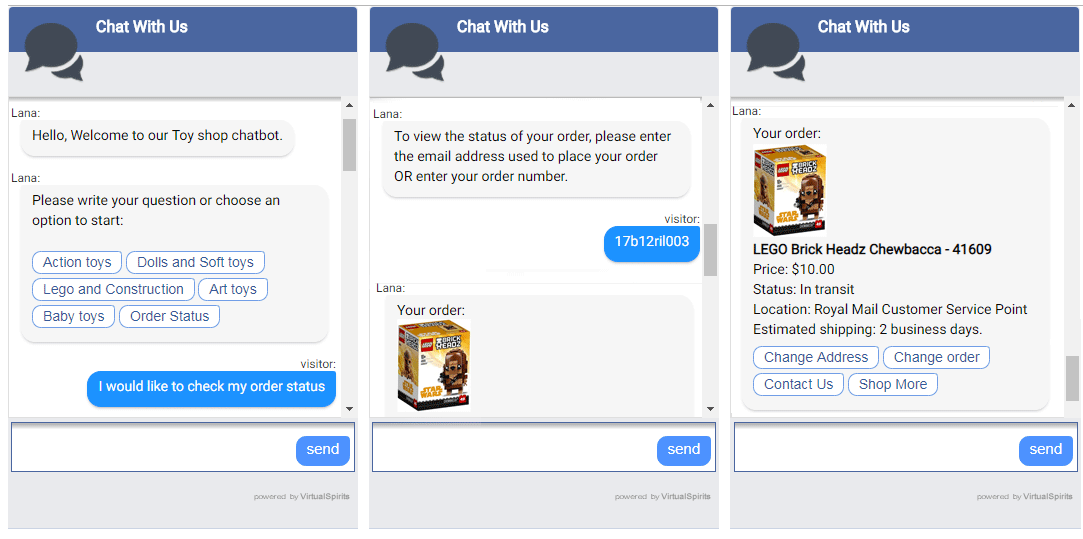
TOPICS:
Chatbot for Ecommerce Chatbot Optimization
Ecommerce Chatbot – What Can Ecommerce Store Chatbots Do For You?
The internet has permanently changed the way people shop and the ecommerce chatbot will continue this trend. ‘Online’ is now the default when it comes to searching for goods and services. The speed and convenience of online shopping has led to the incremental growth of the ecommerce market, prompting brands to set up shop in various online marketplaces, social media channels, and of course, through their own ecommerce websites.
The over-saturation of ecommerce sites in the market has made it harder for brands to stand out. As a business owner, you can’t afford miss out on traffic and conversions because your website offers a sub-par shopping experience. The good news is that the ideal tool for increasing leads, conversions and visitor retention rates already exists – in the shape of ecommerce chatbots.

Here’s a glimpse of what an AI-powered chatbot can do for your ecommerce store.
1. Increase visitor engagement:
Customers often look at the same product on different ecommerce websites. They make comparisons, search for promotional offers, and weigh the convenience of shipping options. Which is why it helps to look at your chatbot as a powerful lead generation tool.
Take for example, Alan, a 30-year-old avid cyclist who happens to be browsing through different online stores for the best GPS for his bike. He chances upon Tracker A, a GPS device that is way beyond his budget. He then decides to limit his search to options within his price range. A second device, Tracker B, is cheaper but comes with limited features. No longer sure about which GPS device to choose, Alan decides to ask the online chatbot for help.
Chatbot: “Hello. How can I help you?”
Alan: “I need a GPS for my bike. Tracker A is beyond my budget. Can you tell me what features Tracker B offers that Tracker A doesn’t?
Chatbot: “Thank you for your question. Tracker B is universal, so you can use it to keep track of other objects, people, and even pets.
Additionally, it comes with a built-in SIM card, meaning you can travel to any country without worrying about which carrier you’re using. The brand offers a one-year warranty, which can be extended at a nominal fee.”
Alan: “Cool! Will check it out.”
Chatbot: “We can provide you with detailed information about both trackers as well as a comprehensive comparison. Do you have an email address where I can send this information?”
Alan: “Sure, Alan@sampleemail.com.”
Chatbot: “Thank you! You should get the email in a moment. Do you have any other queries?”
Alan: “No, I’m good, thank you.”
Chatbot: “Happy to help! Feel free check out our blogs or FAQs section for more assistance.”
The methods employed by the ecommerce chatbot above may not directly lead Alan into making a purchase. But they do lead him down a sales funnel by allowing him to learn more about the products and eventually make a decision to shop from the online store in question.
2. Get customers to complete their purchase:
Abandoned shopping carts are a challenge that online stores are constantly looking to overcome. Surveys show that as many as
57% of online users choose to abandon their purchases due to indecisiveness. Their reasons for feeling unsure are usually minor – they could just be missing a piece of information about the product, or about the website’s shipping and returns policies. But these small information gaps are usually enough to deter them from going through with their purchase.
If you create a chatbot for online store, it can get to work during this crucial pre-checkout stage and help your customers with their concerns. Besides being a problem solver, the AI bot also personalizes every customer’s shopping experience. The best chatbots for ecommerce websites implement multi-tier strategies to prevent shopping cart abandonment. These include fetching product details, conducting product comparisons, upselling and cross-selling, and offering limited-period discounts on the items in the cart.
3. Track shipments and provide order updates:
After making a purchase, customers want to be updated on the status of their order, especially if the shipment seems to be taking longer than expected. By building chatbots for their websites, ecommerce businesses can offer on-demand tracking information, as shown in the example below:
Customer: “I would like to track an order”
Chatbot: “Sure thing! May I know the order tracking ID?”
Customer: “[Tracking ID].”
Chatbot: “Thanks! Upon checking, I see that your order is already in transit. Your package should arrive within the day. In case you don’t receive it before 17:00hrs today, please let me know and I’ll look into it.”
Customers always appreciate a quick update. Instead of having them go through the painstakingly long process of calling and following up with customer service, online chatbots allow them to conveniently track their orders by via instant messaging.
4. Simplify the buying process for your customers:
When shopping at brick-and-mortar stores, people appreciate the assistance of salespersons and shop attendants. By deploying a chatbot on your website, you can provide your visitors with a similar shopping experience that replicates that of an actual store.
In addition to product-related information, ecommerce chatbot can also provide in-store recommendations to help your business generate leads and increase conversion exponentially.
Follow our blog to catch the latest updates and insights on ecommerce chatbot development, or get in touch with us if you need help building the best chatbot for your online store.